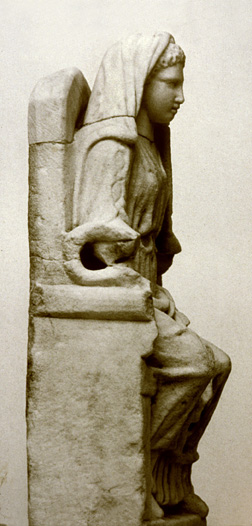Women's Mysteries in Rome: Fenta Fauna and Female Resistance
Download illustrated pdf here.
© 2015 Max Dashu Excerpted from Vol III Secret History of the WitchesSHORT TASTE:
Bona Dea, the Good Goddess
The priestesses of Bona Dea ran an herbarium: “... all kinds of herbs are found in her temple, from which the priestesses mostly make medicines which they distribute...” Snakes and healing herbs were also kept at the grove of the goddess Angitia or Anguitina at lake Fuscinus. [Piscinus, online]
One of the finest sculptures of Bona Dea. Although her arm is broken off, the serpent is still visible coiled beside her.
Inscriptions shower Bona Dea with titles: Caelestis, Augusta, Sancta (“holy”), Regina Triumphali, Lucifera (“light-bringing”), Obsequens (“well-disposed”), Opifera (“aid-bringing”), Pagana, Agrestis and Sevina (goddess of the countryside, fields, and seeds). As Domina (“lady”), she is thanked in an inscription for healing an eye disease. She is linked to other goddesses who share her titles: Fortuna, Ceres, Juno, the Parcae, Hygeia, and Venus Cnidia.
Ceremonies on the Aventine
The center of the ecstatic Mysteries was the Aventine hill. This rural and plebeian district of Rome was home to some of its oldest temples: those of Carmenta, Diana, and Mercury. Plebeian worship of the Aventine triad—Ceres, Liber and Libera—thrived there. This hill was also the headquarters of Bona Dea, whose sanctuary was reputed to be most ancient. It seems to have been an open air shrine around a cave or rock shelter, as in paleolithic and neolithic times. Its Aventine neighborhood was named Bonadensis after the Goddess, and a mention survives of “the women of the Bona Dea quarter” being treated to mead and cakes.
Ceres-Demeter with serpents, grain, and poppies
These rites blended easily with the Aventine mysteries of Ceres, Stimula and Mater Matuta. On certain days the women raised a lamentation at every crossroads, as Demeter had cried out and, as Servius observed, like the women who wailed in the rite of Isis. [Spaeth, 107] There's ample evidence that Bona Dea syncretized with other goddesses, especially her Aventine sister Diana, who appears with her in dedications. She also was conflated with Syrian Atargatis and the Carthaginian “All-Mother” who became known as Juno Caelestis. A Tiburtine inscription is dedicated “To Holiest Bona Dea Caelestis.” [79, 392] In faraway Chesters, north England, a dedication was found to Bona Dea, Queen of Heaven, harking back to the same ancient Semitic roots. [139] ...
© Max Dashu 2015

